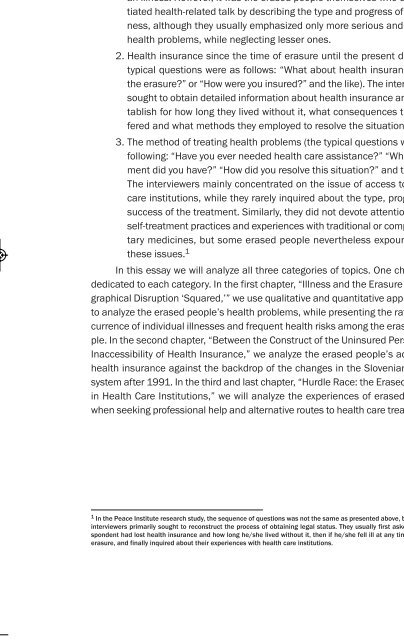The Scars of the Erasure_web
The Scars of the Erasure_web
The Scars of the Erasure_web
- No tags were found...
You also want an ePaper? Increase the reach of your titles
YUMPU automatically turns print PDFs into web optimized ePapers that Google loves.
<strong>Erasure</strong>_4a 10.1.11 20:29 Page 152152 THE SCARS OF THE ERASURE1. A description <strong>of</strong> health problems (<strong>the</strong>se were <strong>the</strong> typical questions:“Have you had any health problems since <strong>the</strong> time <strong>of</strong> <strong>the</strong> erasure?” or“Have you fallen ill at any point in time since <strong>the</strong> erasure?” or similar).<strong>The</strong> interviewers mainly sought to establish <strong>the</strong> potential presence <strong>of</strong>an illness. However, it was <strong>the</strong> erased people <strong>the</strong>mselves who <strong>of</strong>ten initiatedhealth-related talk by describing <strong>the</strong> type and progress <strong>of</strong> <strong>the</strong>ir illness,although <strong>the</strong>y usually emphasized only more serious and chronichealth problems, while neglecting lesser ones.2. Health insurance since <strong>the</strong> time <strong>of</strong> erasure until <strong>the</strong> present date (<strong>the</strong>typical questions were as follows: “What about health insurance after<strong>the</strong> erasure?” or “How were you insured?” and <strong>the</strong> like). <strong>The</strong> interviewerssought to obtain detailed information about health insurance and to establishfor how long <strong>the</strong>y lived without it, what consequences <strong>the</strong>y sufferedand what methods <strong>the</strong>y employed to resolve <strong>the</strong> situation.3. <strong>The</strong> method <strong>of</strong> treating health problems (<strong>the</strong> typical questions were <strong>the</strong>following: “Have you ever needed health care assistance?” “What treatmentdid you have?” “How did you resolve this situation?” and <strong>the</strong> like).<strong>The</strong> interviewers mainly concentrated on <strong>the</strong> issue <strong>of</strong> access to healthcare institutions, while <strong>the</strong>y rarely inquired about <strong>the</strong> type, progress orsuccess <strong>of</strong> <strong>the</strong> treatment. Similarly, <strong>the</strong>y did not devote attention to <strong>the</strong>self-treatment practices and experiences with traditional or complementarymedicines, but some erased people never<strong>the</strong>less expounded on<strong>the</strong>se issues. 1In this essay we will analyze all three categories <strong>of</strong> topics. One chapter isdedicated to each category. In <strong>the</strong> first chapter, “Illness and <strong>the</strong> <strong>Erasure</strong> – A Bio -graphical Disruption ‘Squared,’” we use qualitative and quantitative approachesto analyze <strong>the</strong> erased people’s health problems, while presenting <strong>the</strong> rate <strong>of</strong> occurrence<strong>of</strong> individual illnesses and frequent health risks among <strong>the</strong> erased people.In <strong>the</strong> second chapter, “Between <strong>the</strong> Construct <strong>of</strong> <strong>the</strong> Uninsured Person andInaccessibility <strong>of</strong> Health Insurance,” we analyze <strong>the</strong> erased people’s access tohealth insurance against <strong>the</strong> backdrop <strong>of</strong> <strong>the</strong> changes in <strong>the</strong> Slovenian healthsystem after 1991. In <strong>the</strong> third and last chapter, “Hurdle Race: <strong>the</strong> Erased Peoplein Health Care Institutions,” we will analyze <strong>the</strong> experiences <strong>of</strong> erased peoplewhen seeking pr<strong>of</strong>essional help and alternative routes to health care treatments.1 In <strong>the</strong> Peace Institute research study, <strong>the</strong> sequence <strong>of</strong> questions was not <strong>the</strong> same as presented above, because <strong>the</strong>interviewers primarily sought to reconstruct <strong>the</strong> process <strong>of</strong> obtaining legal status. <strong>The</strong>y usually first asked if <strong>the</strong> respondenthad lost health insurance and how long he/she lived without it, <strong>the</strong>n if he/she fell ill at any time after <strong>the</strong>erasure, and finally inquired about <strong>the</strong>ir experiences with health care institutions.


